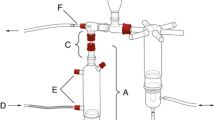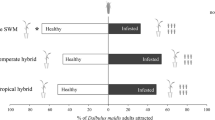Abstract
Plants attacked by insects release volatile compounds that attract the herbivores' natural enemies. This so-called indirect defense is plastic and may be affected by an array of biotic and abiotic factors. We investigated the effect of fungal infection as a biotic stress agent on the emission of herbivore-induced volatiles and the possible consequences for the attraction of two parasitoid species. Maize seedlings that were simultaneously attacked by the fungus Setosphaeria turcica and larvae of Spodoptera littoralis emitted a blend of volatiles that was qualitatively similar to the blend emitted by maize that was damaged by only the herbivore, but there was a clear quantitative difference. When simultaneously challenged by fungus and herbivore, the maize plants emitted in total 47% less of the volatiles. Emissions of green leaf volatiles were unaffected. In a six-arm olfactometer, the parasitoids Cotesia marginiventris and Microplitis rufiventris responded equally well to odors of herbivore-damaged and fungus- and herbivore-damaged maize plants. Healthy and fungus-infected plants were not attractive. An additional experiment showed that the performance of S. littoralis caterpillars was not affected by the presence of the pathogen, nor was there an effect on larvae of M. rufiventris developing inside the caterpillars. Our results confirm previous indications that naïve wasps may respond primarily to the green leaf volatiles.



Similar content being viewed by others
References
Agrawal, A. A., Tuzun, S., and Bent, E. (eds.). 1999. Induced Plant Defenses against Pathogens and Herbivores. The American Phytopathological Society.
Alborn, H. T., Turlings, T. C. J., Jones, T. H., Stenhagen, G., Loughrin, J. H., and Tumlinson, J. H. 1997. An elicitor of plant volatiles from beet armyworm oral secretion. Science 276:945–949.
Borchardt, D. S., Welz, H. G., and Geiger, H. H. 1998. Molecular marker analysis of European Setosphaeria turcica populations. Eur. J. Plant Pathol. 104:611–617.
CAB International. 1988. Distribution maps of plant diseases. Map No. 257, ISSN 0012-396X.
Cardoza, Y. J., Alborn, H. T., and Tumlinson, J. H. 2002. In vivo volatile emissions from peanut plants induced by simultaneous fungal infection and insect damage. J. Chem. Ecol. 28:161–174.
Cardoza, Y. J., Lait, C. G., Schmelz, E. A., Huang, J., and Tumlinson, J. H. 2003a. Fungus-induced biochemical changes in peanut plants and their effect on development of beet armyworm, Spodoptera exigua Hubner (Lepidoptera: Noctuidae) larvae. Environ. Entomol. 32:220–228.
Cardoza, Y. J., Teal, P. E. A., and Tumlinson, J. H. 2003b. Effect of peanut plant fungal infection on oviposition preference by Spodoptera exigua and on host-searching behavior by Cotesia marginiventris. Environ. Entomol. 32:970–976.
D'Alessandro, M. and Turlings, T. C. J. (2005). In situ modification of herbivore-induced plant odours: A novel approach to study the attractiveness of volatile organic compounds to parasitoids. Chem. Senses 30:739–753.
De Boer, J. G. and Dicke, M. 2004. Experience with methyl salicylate affects behavioural responses of a predatory mite to blends of herbivore-induced plant volatiles. Entomol. Exp. Appl. 110:181–189.
De Moraes, C. M., Lewis, W. J., Pare, P. W., Alborn, H. T., and Tumlinson, J. H 1998. Herbivore-infested plants selectively attract parasitoids. Nature 393:570–573.
Devoto, A. and Turner, J. G. 2003. Regulation of jasmonate-mediated plant responses in Arabidopsis. Ann. Bot. 92:329–337.
Dicke, M. 1999. Are herbivore-induced plant volatiles reliable indicators of herbivore identity to foraging carnivorous arthropods? Entomol. Exp. Appl. 91:131–142.
Dicke, M. and Sabelis, M. W. 1988. How plants obtain predatory mites as bodyguards. Neth. J. Zool. 38:148–165.
Felton, G. W. and Korth, K. L. 2000. Trade-offs between pathogen and herbivore resistance. Curr. Opin. Plant Biol. 3:309–314.
Fidantsef, A. L., Stout M. J., Thaler, J. S., Duffey, S. S., and Bostock, R. M. 1999. Signal interactions in pathogen and insect attack: Expression of lipoxygenase, proteinase inhibitor II, and patho genesis-related protein P4 in the tomato, Lycopersicon esculentum. Physiol. Mol. Plant Pathol. 54:97–114.
Gerling, D. 1969. The parasites of Spodoptera littoralis (Boisd.) (Lepidoptera; Noctuidae) eggs and larvae in Israel. Isr. J. Entomol. 4:73–81.
Gouinguené, S. P. and Turlings, T. C. J. 2002. The effects of abiotic factors on induced volatile emissions in corn plants. Plant Physiol. 129:1296–1307.
Gouinguené, S., Degen, T., and Turlings, T. C. J. 2001. Variability in herbivore-induced odour emissions among maize cultivars and their wild ancestors (teosinte). Chemoecology 11:9–16.
Guerrieri, E., Poppy, G. M., Powell, W., Tremblay, E., and Pennacchio, F. 1999. Induction and systemic release of herbivore-induced plant volatiles mediating in-flight orientation of Aphidius ervi. J. Chem. Ecol. 25:1247–1261.
Hatcher, P. E. 1995. Three-way interactions between plant pathogenic fungi, herbivorous insects and their host plants. Biol. Rev. 70:639–694.
Heath, R. R. and Manukian, A. 1992. Development and evaluation of systems to collect volatile semiochemicals from insects and plants using a charcoal-infused medium for air purification. J. Chem. Ecol. 18:1209–1226.
Hegazi, E. M. 1977. Further studies on certain natural enemies attacking the cotton leafworm in Alexandria region. PhD thesis. University of Alexandria, Egypt.
Hilker, M. and Meiners, T. 2002. Induction of plant responses to oviposition and feeding by herbivorous arthropods: A comparison. Entomol. Exp. Appl. 104:181–192.
Hoballah, M. E. F. 2001. Benefits, costs and exploitation of caterpillar-induced odor emissions in maize plants. Ph.D. thesis, University of Neuchâtel, Switzerland.
Hoballah, M. E. F. and Turlings, T. C. J. 2001. Experimental evidence that plants under caterpillar attack may benefit from attracting parasitoids. Evol. Ecol. Res. 3:553–565.
Hoballah, M. E. F., Tamo, C., and Turlings, T. C. J. 2002. Differential attractiveness of induced odors emitted by eight maize varieties for the parasitoid Cotesia marginiventris: Is quality or quantity important? J. Chem. Ecol. 28:951–968.
James, D. G. 2003a. Field evaluation of herbivore-induced plant volatiles as attractants for beneficial insects: Methyl salicylate and the green lacewing, Chrysopa nigricornis. J. Chem. Ecol. 29:1601–1609.
James, D. G. 2003b. Synthetic herbivore-induced plant volatiles as field attractants for beneficial insects. Environ. Entomol. 32:977–982.
Karban, R. and Baldwin, I. T. 1997. Induced Responses to Herbivory. University of Chicago Press, Chicago.
Loughrin, J. H., Manukian, A., Heath, R. R., and Tumlinson, J. H. 1995. Volatiles emitted by different cotton varieties damaged by feeding beet armyworm larvae. J. Chem. Ecol. 21:1217–1227.
Molina-Ochoa, J., Carpenter, J. E., Heinrichs, E. A., and Foster, J. E. 2003. Parasitoids and parasites of Spodoptera frugiperda (Lepidoptera: Noctuidae) in the Americas and Caribbean Basin: An inventory. Fla. Entomol. 86:254–289.
Peacock, L., Lewis, M., and Powers, S. 2001. Volatile compounds from Salix spp. varieties differing in susceptibility to three willow beetle species. J. Chem. Ecol. 27:1943–1951.
Preston, C. A., Lewandowski, C., Enyedi, A. J., and Baldwin, I. T. 1999. Tobacco mosaic virus inoculation inhibits wound-induced jasmonic acid-mediated responses within but not between plants. Planta 209:87–95.
Rodriguez-Saona, C., Crafts-Brandner, S. J., and Canas, L. A. 2003. Volatile emissions triggered by multiple herbivore damage: Beet armyworm and whitefly feeding on cotton plants. J. Chem. Ecol. 29:2539–2550.
Rostás, M., Simon, M., and Hilker, M. 2003. Ecological cross-effects of induced plant responses towards herbivores and phytopathogenic fungi. Basic Appl. Ecol. 4:43–62.
Ruther, J. and Kleier, S. 2005. Plant–plant signaling: Ethylene synergizes volatile emission in Zea mays induced by exposure to (Z)-3-hexen-1-ol. J. Chem. Ecol. 31:2217–2222.
Schmelz, E. A., Alborn, H. T., Banchio, E., and Tumlinson, J. H. 2003a. Quantitative relationships between induced jasmonic acid levels and volatile emission in Zea mays during Spodoptera exigua herbivory. Planta 216:665–673.
Schmelz, E. A., Alborn, H. T., and Tumlinson, J. H. 2003b. Synergistic interactions between volicitin, jasmonic acid and ethylene mediate insect-induced volatile emission in Zea mays. Physiol. Plantarum 117:403–412.
Takabayashi, J., Takahashi, S., Dicke, M., and Posthumus, M. A. 1995. Developmental stage of herbivore Pseudaletia separata affects production of herbivore-induced synomone by corn plants. J. Chem. Ecol. 21:273–287.
Thaler, J. S., Karban, R., Ullman, D. E., Boege, K., and Bostock, R. M. 2002. Cross-talk between jasmonate and salicylate plant defense pathways: Effects on several plant parasites. Oecologia 131:227–235.
Turlings, T. C. J., Tumlinson, J. H., and Lewis, W. J. 1990. Exploitation of herbivore-induced plant odors by host-seeking parasitic wasps. Science 250:1251–1253.
Turlings, T. C. J., Loughrin, J. H., McCall, P. J., Rose, U. S. R., Lewis, W. J., and Tumlinson, J. H. 1995. How caterpillar-damaged plants protect themselves by attracting parasitic wasps. Proc. Natl. Acad. Sci. U.S.A. 92:4169–4174.
Turlings, T. C. J., Gouinguene, S., Degen, T., and Fritsche-Hoballah, M. E. 2002. The chemical ecology of plant–caterpillar–parasitoid interactions, pp. 148–173, in T. Tscharntke and B. Hawkins (eds.). Multitrophic Level Interactions. Cambridge University Press, Cambridge.
Turlings, T. C. J., Davison, A. C., and Tamo, C. 2004. A six-arm olfactometer permitting simultaneous observation of insect attraction and odour trapping. Physiol. Entomol. 29:45–55.
Van Poecke, R. M. P. and Dicke, M. 2004. Indirect defence of plants against herbivores: Using Arabidopsis thaliana as a model plant. Plant Biol. 6:387–401.
Vet, L. E. M. and Dicke, M. 1992. Ecology of infochemical use by natural enemies in a tritrophic context. Annu. Rev. Entomol. 37:141–172.
Walling, L. L. 2000. The myriad plant responses to herbivores. J. Plant Growth Regul. 19:195–216.
Acknowledgments
We wish to thank Cristina Faria, Cristina Tamò, Marco d'Alessandro, and Matthias Held for discussions and technical assistance. We also thank Syngenta for supplying us with eggs of S. littoralis. This work was supported by the Deutsche Forschungsgemeinschaft (grant to Michael Rostás, Ro2409/1-1) and the Swiss National Centre of Competence in Research “Plant Survival.” All experiments complied with current laws in Switzerland.
Author information
Authors and Affiliations
Corresponding author
Rights and permissions
About this article
Cite this article
Rostás, M., Ton, J., Mauch-Mani, B. et al. Fungal Infection Reduces Herbivore-Induced Plant Volatiles of Maize but does not Affect Naïve Parasitoids. J Chem Ecol 32, 1897–1909 (2006). https://doi.org/10.1007/s10886-006-9147-3
Received:
Revised:
Accepted:
Published:
Issue Date:
DOI: https://doi.org/10.1007/s10886-006-9147-3




